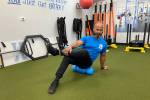Sit down seven times, stand up eight
It’s not fair. It seems like there are certain people who almost never gain weight, and if they do, they can lose it easily, while others pack on the pounds with every extra morsel of food they eat and have to sweat off every ounce. There may be an explanation for this frustrating circumstance, and there’s something you can do about it, even if your job requires you to sit at a desk all day.
Dr. James Levine, a researcher at the Mayo Clinic in Rochester, Minn., is on the cutting edge of an emerging field called inactivity studies, which has challenged long-held beliefs about human health and weight. Traditional activity-and-obesity research has relied on people’s recollections of how much they ate and exercised. But the participants in Levine’s study were wired up to a specially designed garment that measured their activity levels, and they ate in the laboratory’s research kitchen.
They were told not to exercise, as the goal of the study was to determine why some people consuming the same amount of calories gained weight, while others didn’t. After determining how many calories each of his subjects needed to maintain their weight, Levine began to feed them 1,000 extra calories a day. As he projected, some gained weight, while others gained little to no weight.
As reported by James Vlahos in The New York Times in the article, “Is Sitting a Lethal Activity?” Dr. Michael Jensen, a Mayo Clinic researcher who collaborated with Levine on the studies, said, “We measured everything, thinking we were going to find some magic metabolic factor that would explain why some people didn’t gain weight.”
When they did find the answer, it came from data gathered through having people wear the special garment designed to measure their activity.
“The people who didn’t gain weight were unconsciously moving around more,” Jensen said.
They hadn’t started exercising more, since not exercising was part of the study agreement. But these people naturally made more daily movements than they had before the overfeeding began, like taking the stairs, walking to a colleague’s desk to ask a question, bustling with chores or simply being a fidgety sitter. The people who gained weight were sedentary two hours more per day than those who had maintained their weight.
The conventional notion is that if you watch your calories and add aerobic exercise at least a few times a week, you will offset your sedentary time and stay in good shape. Levine’s study calls that idea into question.
Marc Hamilton, an inactivity researcher at the Pennington Biomedical Research center, said, “Exercise is not a perfect antidote for sitting.”
When we sit, electrical activity in our muscles drops, and within 24 hours, our calorie-burning rate drops, the effectiveness with which our bodies handle insulin drops and the risk of developing Type 2 diabetes rises.
“Excessive sitting is a lethal activity,” Levine said.
If you have a job that requires you to stay seated most of the day, it can be challenging, but there are things you can do to take charge of your activity level and your health.
Dr. Robert Vance, practicing in general internal medicine with emphasis on nutrition and whole body wellness, including osteopathic spinal manipulation, has been in the Las Vegas Valley for 12 years. He and Dr. Michael Reiss of Southern Nevada Chiropractic, practicing since 1998, with 15 years in Las Vegas, share some advice.
Counteracting Prolonged Sitting
“Movement is health. Rigidity is death,” Vance said. “Prolonged sitting impedes lymphatic drainage leading to swelling of the legs, causes venous blood flow congestion in the legs leading to clots, creates an abnormal flexion of the sacrum leading to low back pain, and causes a person to hunch forward leading to an increased strain on the muscles of the upper back, shoulder, and neck. These stresses on the mechanics of the body then can increase risk of headaches, carpal tunnel, abdominal discomfort, hemorrhoids, varicose veins, and furthermore lead to serious health consequences like the development of obesity, cardiometabolic syndrome, diabetes, and heart disease.”
He added, “The two most important preventive actions are to maintain a properly erect spine and improve range of motion. The work station must follow ergonomic principles. The seat should allow the natural curve of the low back and shoulder to contact and be maintained by the back of the chair. The arms and wrist should be at midchest level. Feet should be able to be placed flat. The eyes should look straight forward to the computer screen and not at an angle. An employee can request a different chair and a raised or lowered desk.”
Vance noted that the Japanese showed us the power of employee health and reduction in sick days by having their workers do tai chi stretching at work.
“A quick standing and stretching at the desk, moving as many body parts in all the directions, will relieve strain,” Vance said. “Keep a stool under the desk to alternately elevate the feet. Wear support hose or socks to minimize swelling.”
“Low back pain is exacerbated by sitting because the abdominal muscles virtually disengage and stop supporting our posture,” Reiss said. “An easy thing to do while at your desk is simply contracting your abs 10 to 15 times every 20 minutes. The contraction should feel as if you are just about to fake a cough.”
In addition, Reiss recently read that eye doctors are seeing many patients with vision problems because of sitting in front of computers for long hours. Since the eyes have muscles that control them as well, doctors came up with simple eye exercises, called “20/20/20,” a play on 20/20 perfect vision. Reiss said, “Every 20 minutes, focus your eyes on an object that is 20 feet away for 20 seconds. I encourage ‘sitters’ to do this exercise, and I ask that they do it while standing, in order to break up the monotony of sitting.”
Another activity Reiss recommends that can be done while sitting, can burn calories and engages the abdominal muscles is pelvic stretches, which is “basically sitting and pretending to do the hula hoop,” as Reiss describes it. Another way to make movement fun, according to Reiss, is having sitters stand up every time the phone rings.
“Move those feet or knees while seated,” Vance said. “Take the stairs instead of the elevator. Park farther away from the office for increased walking. On your lunch break, bring tennis shoes and do several laps around the building or up and down the stairs. Sit on a pillow or “pregnancy” doughnut. Stay hydrated by frequently sipping cool water with a bit of fresh squeezed lemon. Get some sunshine on your face and in your eyes daily for cortisol/adrenal support. Stimulate brain blood flow by doing word puzzles, crocheting or reading a novel on breaks. Use a battery-charged muscle massager on breaks.”
In addition, Vance recommends we make our workspaces as conducive to health as possible. His suggestions include making smart food choices in the lunchroom, keeping healthy snacks at your desk such as pecans and raisins or turkey jerky to keep blood levels steady, keeping family photos, a plant, soft background music and a favorite light scent nearby such as citrus or cinnamon in a candle or potpourri container and placing a daily funny or thoughtful quote to read near your desk. He also suggests we learn to laugh and smile more.
“Laughing and smiling release endorphins, which relieve pain and help us relax,” Vance said.
He also suggests we take five minutes to do some deep breathing, visualizing a quiet beach while breathing in through the nose and out the mouth, increasing the length each breath.
Activities Outside the Work Day
To begin with, Vance said we can’t underestimate the value of a proper night’s sleep. He also said eating fewer starches at night is beneficial because starches turn to fat when activity drops.
Those who are required to sit for a large portion of their work day simply must add activity later, according to these doctors.
“Walking 20 minutes is a good start, to be done every day. Bottom line, as humans, if it’s not fun, we won’t be consistent with our exercise,” Reiss said. “So to make it a habit, find a workout that you really enjoy doing and you won’t want to miss one as frequently as an activity you dread, but you read was good for you. Workouts like Crossfit are becoming very popular because they are rarely the same twice.”
“Continue the stretching and movement routine. Get outdoors. Exercise is as important and effective as drugs at treating heart disease and diabetes. Studies have shown improved health outcomes for overweight individuals who exercised but did not diet compared to those who dieted but did not exercise,” Vance said.
Nutritional Advice
Reiss gives this advice to all his patients: “There is little debate that fresh, whole foods are the best for keeping our bodies working well. Avoid foods filled with preservatives, colorings, additives and flavorings.
As a general rule, I advocate the 80/20 rule. Eighty percent of your diet should be fresh whole food (fruits, vegetables, lean meats, nuts, healthy oil like coconut) and 20 percent of the time, go crazy if you feel like it.”
Reiss notes that one supplement that is being studied is fish oil, particularly the omega-3 fatty acid derived from the oil.
“Research shows large amounts of omega-3s reduce the inflammatory process that leads to many chronic conditions associated with inactivity,” he said.
“A diet high in antioxidants such as berries and cruciferous vegetables such as kale, broccoli, cauliflower and Brussels sprouts is best,” Vance added. Minimize or avoid caffeine, sugary drinks and highly processed foods. Consider starting juicing or blending whole fruits and veggies. Increase fiber. Add chia or flaxseed. Take vitamin D and omega-3 oils. Get on a basic multivitamin and mineral supplement. Consider an aspirin regimen, under the advice of your health care provider.”
If you are experiencing pain, Vance said to treat immediately.
“Don’t wait for it to become chronic,” he said. “Use hot packs, warming gels, or apply essential oils to tight muscles. Take the recommended levels of over-the-counter pain relievers and follow-up with your health provider for those areas that don’t respond. Natural anti-inflammatories include willow bark, boswellia, arnica, capsaicin, curcumin, olive leaf, rosemary, or reduced isoalpha alkaloids of hops. Joint inflammation and flexibility may respond to a combination of MSM, glucosamine and chondroitin. Topical essential oils may reduce pain and swelling.”
Health Problems to Watch For
As with any job requiring certain repetitive activity every day, people whose job requires them to stay tethered to a desk need to keep an eye out for potential health problems that might arise.
Vance advises patients to watch for, “pain that doesn’t resolve, swelling of legs that doesn’t go away by the morning, numbness of the hands or fingers and unexplained changes that don’t resolve if advice about diet and activity are incorporated.”
Reiss advises his patients, “Fluctuations in energy levels, excessive tiredness during the day and pain in general are indicators that something is not working well in the body.” He recommends an annual physical, including a blood panel, to alert you to many potential problems.
“It has been said if you want to stay healthy, stay away from the doctor,” Vance said. “Depending on who you choose to use as a health care provider, there may be some truth to that. Seek out someone knowledgeable in body mechanics, nutrition, and wellness who will take time to listen and teach. Anyone can order a standard lab test, but it takes an insightful and caring practitioner to know which one to order for the individual.”
Specific blood testing Vance might recommend for a desk-bound person include tests for cholesterol, insulin, sugar, homocysteine, high-sensitivity C reactive protein, vitamin D, omega 3 levels, thyroid, and vitamin B12. Additional testing might include a vitamin panel or evaluation of cortisol levels (adrenals). Further tests might include an ultrasound of the lower legs for varicose vein competency evaluation. Additionally, for a person with hand, finger or upper arm numbness and pain, an electromyography of the upper extremities might be ordered.
There is a Japanese proverb, Nanakorobi yaoki, sometimes attributed to Confucius. It means, “Fall seven times and stand up eight.” The generally understood idiomatic meaning of this proverb is, “When life knocks you down, get back up and keep trying.” If life is sitting you down seven times, stand up eight. Your body will thank you.






























